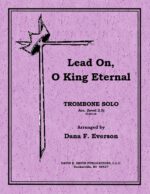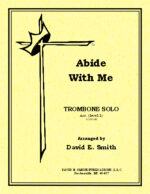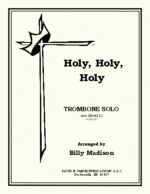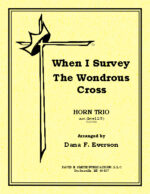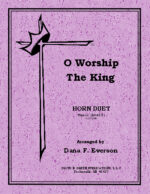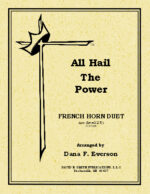-
But Whom May Abide The Day…
$4.00Taken from the “Messiah”, this solo with piano is essentially a transcription of the original work. It features sufficient counterpoint between the various instruments.
-
Lead On O King Eternal
$4.50Originally in a duple meter this arrangement very cleverly is in a 6-8 march style. It progresses in a rather processional manner and then transitions to a slower reflective expression. The piece returns to its former style and then ends on a declamatory note.
-
O Mighty God
$4.50After a majestic introduction the piece settles down into a softer and more expressive rendition of the tune “How Great Thou Art.” The middle section is a variation of the first section with the melody in the piano while the soloist plays an obbligato styled line. Then the piano present a transition in a majestic style modulating to a new key with the solo line presenting the tune in again expressive style with a lot of dynamic shading. The piece concludes in a majestic sense of finality.
-
Jesus Is The Sweetest Name I Know
$4.50A brass solo that begins with a reflective piano introduction that is then joined in by the soloist. The tune is true to the original with little embellishment. A brief piano interlude gives over to the melody in the piano while covered by an sonorous obbligato in the solo line. The piece ends with a gentle motive and then settles in a sweet repose in the piano.
-
Faith Is The Victory
$4.00This solo with piano starts out in a march triumphal style with a short introduction. The first section is stated in a rather familiar rendition of the melody in varied rhythmic devices. The middle section is a complete change of pace being slower and expressive. With a tempo increase the pieces orients itself back to the first style and tempo. The Coda starts at low ebb and melodically grows until it ends on a high note- then a solid final figure.
-
Softly And Tenderly
$4.00A gentle introduction by the piano and then the solo trombone presents the theme with subtle rhythmic deviation. The chorus continues in the same fashion. A quick modulation and the theme continues in a modified fashion with even more scale wise embellishment. The piano then takes over with the tune and with another modulation the solo enters with more harmonic deviation. The Coda section moves with subtle motivic deviation and comes to a solemn rest.
-
Jesus Loves Me
$4.00This solo with piano is constructed in a rondo form alternating the tunes of Jesus Loves Me, Praise Him All Ye Little Children and Jesus Loves The Little Children. Each section of the piece is in a different style thereby giving a great deal of variety technically and musically for the younger player.
-
My Faith Looks Up To Thee
$4.00After a brief introduction the trombone solo enters with the theme with a piano line that is rather alla-Baroque. The next section is presented in the piano with warm harmonic movement. The middle section is offered by the solo line in a mildly altered tune. This leads to a modulation with textures reminiscent of the previous two styles. The Coda is a majestic conclusion stating the theme of the title.
-
Tis So Sweet to Trust in Jesus
$3.50This solo with piano is structured in a quasi-rondo form. Thus making a great deal of variety in texture, style, and dynamic.It will make the young performer sound more advanced.
-
My Jesus I Love Thee
$3.50This solo with piano begins with a modified melodic statement. It enters into a second section with simple obligati and then returns to a beginning-like statement and ends with a simple coda.
-
Abide With Me
$3.50This solo piece with piano is presented in a straight-forward manner for the younger player with some altered pitches for interest.
-
Dare To Be A Daniel
$3.50This solo with piano begins with the strains of a lion’s roar. Next enters Daniel in a simple fashion followed by a statement in a triumphal march. The lions return-Daniel prevails.
-
Praise Him All Ye Little Children
$3.50This solo with piano begins with a bold march statement with an elongated rhythm of the melody. The middle section is more expressive while the final section imitates the beginning, with a solid statement of faith.
-
Holy, Holy, Holy
$3.50This solo with piano is straight forward in design, giving the young player the opportunity to display dynamic and stylistic variety.
-
Holy, Holy, Holy
$7.00Written for French horn quartet, this pieces creates a solemn presence by the way it interweaves the various parts together. It would work well for a meditation.
-
When I Survey
$8.00A French horn trio with piano accompaniment. The opening statements in the horns are rather solemn while alternately punctuated with piano responses. After some imitative statements the piece lies in repose.
-
O Worship The King
$4.00This is an unaccompanied French horn duet written in a majestic manner. It uses imitative entrances between the parts and modulates upward for a strong finish.
-
The Solid Rock
$4.00This is an unaccompanied French horn duet written in a majestic manner. It uses imitative entrances between the parts and modulates upward for a strong finish.
-
All Hail The Power…
$5.50A good piece to open a service with since it has the character of a jubilant fanfare. The tombone duet lines are solid and ends on a forceful note.(acc.)
-
-
It Is Well With My Soul
$5.00This piece is highly pensive, incorporating the full range of the instrument. Its nature is certain to cause one to reflect the status of his spiritual condition.




